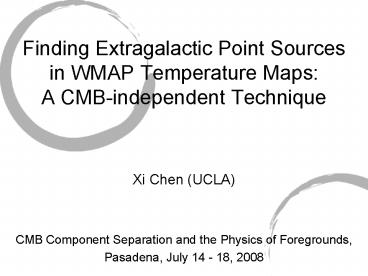Finding Extragalactic Point Sources in WMAP Temperature Maps: A CMBindependent Technique - PowerPoint PPT Presentation
1 / 15
Title:
Finding Extragalactic Point Sources in WMAP Temperature Maps: A CMBindependent Technique
Description:
... and 9.3% of the WMAP three-year cataloged sources are 5 detections at V and W band respectively. ... 291 WMAP cataloged point sources, 75 newly detected sources ... – PowerPoint PPT presentation
Number of Views:64
Avg rating:3.0/5.0
Title: Finding Extragalactic Point Sources in WMAP Temperature Maps: A CMBindependent Technique
1
Finding Extragalactic Point Sources in WMAP
Temperature MapsA CMB-independent Technique
- Xi Chen (UCLA)
- CMB Component Separation and the Physics of
Foregrounds, - Pasadena, July 14 - 18, 2008
2
Outline
- Motivations
- Why CMB-free, why high frequency bands
- Point source search in WMAP V (61 GHz) and W (94
GHz) bands maps - Point source search in WMAP Q (41 GHz), V and W
bands maps - Flat spectrum source favored
- Conclusions
3
Motivations
- Why we want a CMB-independent technique?
- Avoid confusion of positive CMB excursions with
point sources - Improve detection rate with increasing observing
time - WMAP technique (Bennett et al. 2003, Hinshaw
et al. 2007, Wright et al. 2008) - filter Nobs1/2T by
- Why we apply this method to the high frequency
bands WMAP maps? - Only 46.7 and 9.3 of the WMAP three-year
cataloged sources are 5? detections at V and W
band respectively. - Refine the power spectrum model for unresolved
point sources
4
Point Source Search in V W bands
- Smooth W-band map to match V-band resolution
(?Rc1º)
5
- Subtract the smoothed W-band map from the V-band
map
V
WSM
Fig.3. from Bennett et al, 2003
6
- Filter the residual map to get true point source
flux distribution
Minimizing ?2 gives,
7
- Source identification (99 sources in total)
- Cross-correlate our source list with the WMAP
5-yr catalog - (64 are present in the catalog)
- Estimate V-band flux densities of our sources
(17 more are identified using their SEDs)
with
8
- 81 of our sources have low frequency
counterparts - Quasars (58), Galaxies (14), HII regions (9)
- 17 can be associated with extended radio
sources - NGC 1499 (2), Ori Nebula (3), Gum Nebula (8),
Oph Complex (3), Cen A vicinity (1) - 1 remains uncertain
- 1? position uncertainty 1.4
- A 0.012 0.004 ?K2 sr (Chen Wright, 2008)
- A 0.014 0.003 ?K2 sr (Hinshaw et al.,
2007) - A 0.012 0.005 ?K2 sr for l lt 500
(Huffenberger et al., 2007) - A 0.015 0.005 ?K2 sr for l gt 500
9
(No Transcript)
10
Strengths and limitations
- No CMB noise gt low detection threshold and
detection rate increases rapidly with integration
time - N tint0.72 from 1 year to 5 years, compared to
N tint0.39 using the WMAP team method - For Euclidean source counts the expected scaling
is t0.75 - Use maps with high resolution and low foreground
contamination gt better positional accuracy
- Subtraction of maps may cause missing sources.
- for flat spectrum sources, TW 1/2 TV
- V W maps have relatively lower SNR for flat
spectrum sources.
11
Point Source Search in Q, V W bands
- Smooth V- and W-band maps to match Q-band
resolution (?Rc1.25º)
- Construct a linear combination map that is
- CMB free,
- optimized for flat-spectrum source,
- variance minimized,
12
- Use the same Kp0LMCSMC mask
- as in Wright et al., 2008
13
(No Transcript)
14
- 381 sources are detected in the QVW combination
map - 291 WMAP cataloged point sources, 75 newly
detected sources - QSO (269), G (61), GPair (1), GTrpl (1), PN (1),
RadioS (33) - 15 remain uncertain (could be contaminations
from extended radio emissions) - 1? position uncertainty 2.0
15
Conclusions
- We established a CMB-independent method for point
source search in CMB data. - This technique is proved to be reliable,
- 99 detections in V W bands maps (99
identified) 381 detections in Q, V W bands
maps (94 identified) - consistent,
- Sources detected in the first year maps are
repeatedly detected in three-year and five-year
co-added maps. - and complementary to the WMAP technique
- new detections, but not complete
- No sign of a significant different class of new
objects - Contamination from unresolved point sources at
WMAP V-band is negligible, Cv (2.4?0.8)10-3
?K2 sr































